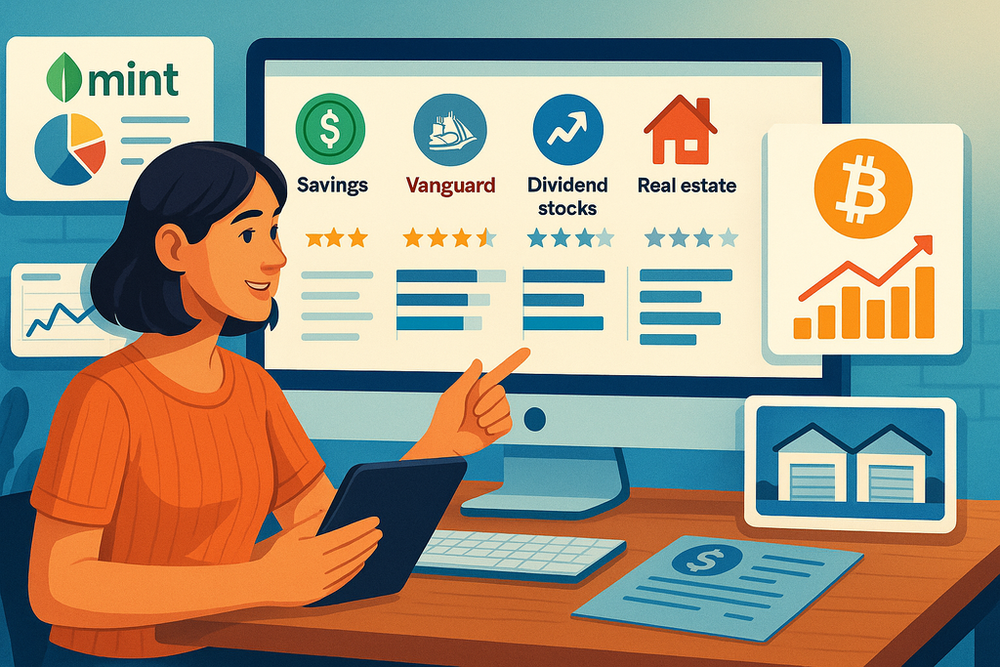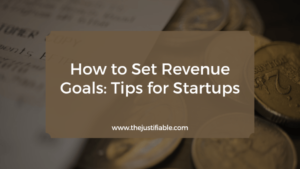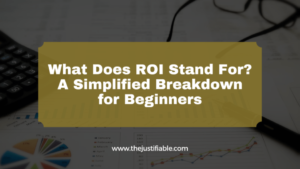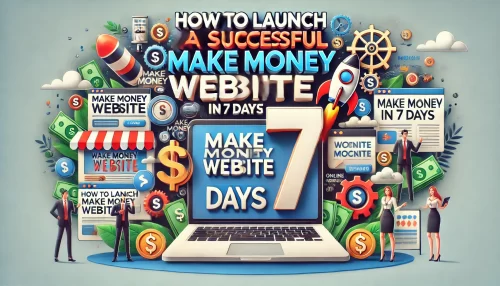Table of Contents
Make your money work for you instead of the other way around—that’s the dream, right? What if your savings didn’t just sit in a bank account collecting dust, but instead started earning for you every single day?
How can you grow wealth faster without waiting decades? Which proven strategies actually get results when you want to see your money multiply quickly?
This article will explore 7 proven ways to make your money work for you fast, breaking each down into practical steps you can use right now.
1. Invest In High-Yield Savings Accounts
High-yield savings accounts are one of the simplest and safest ways to make your money work for you. They don’t require investing knowledge or constant monitoring, and they can immediately start earning you more interest than a traditional bank account.
Why High-Yield Accounts Grow Faster Than Traditional Banks
Traditional banks often pay laughable interest rates—sometimes as low as 0.01%. At that rate, even if you had $10,000 saved, you’d only earn $1 a year.
High-yield accounts, on the other hand, often pay anywhere from 3% to 5% annual percentage yield (APY). That same $10,000 could earn you $300–$500 a year without any extra work.
The difference comes down to how these banks operate. Most high-yield accounts are offered by online-only banks. Since they don’t have the overhead costs of maintaining physical branches, they pass the savings on to you in the form of higher interest.
Over time, this gap in growth compounds, and your savings grow much faster compared to leaving them in a traditional bank.
How To Choose The Right Online Bank For Maximum Returns
When picking a high-yield account, don’t just chase the highest APY—look at the full picture. I suggest checking:
- Minimum balance requirements: Some banks offer high APYs only if you keep a certain amount in the account.
- Fees: Avoid any accounts with monthly maintenance fees, as these can cancel out your earnings.
- Access to funds: Some banks limit the number of withdrawals per month. Make sure you can transfer money easily if needed.
A good example is Ally Bank or Marcus by Goldman Sachs. Both are user-friendly, have no hidden fees, and consistently offer competitive APYs. Personally, I always suggest logging into the mobile app before committing—it gives you a feel for how easy it is to manage your money.
Safety Features And What FDIC Insurance Really Covers
One question I hear a lot is: “Is my money safe in an online bank?” The answer is yes—if the account is FDIC insured.
FDIC stands for the Federal Deposit Insurance Corporation, and it guarantees your deposits up to $250,000 per account, per bank. That means even if the online bank went out of business, your money is protected.
Think of it as a government-backed safety net. The key is to confirm the bank displays “FDIC insured” clearly on their site. If you see this, you can confidently move funds into the account knowing your cash isn’t at risk.
2. Leverage The Power Of Dividend Stocks
Dividend stocks are one of my favorite ways to make your money work for you because they combine two wealth-building engines: steady cash flow and long-term stock growth.
What Dividend Stocks Are And Why They Provide Passive Income
Dividend stocks are shares in companies that regularly pay part of their profits back to shareholders in the form of dividends. Instead of just hoping the stock price rises, you’re getting actual cash payouts, often quarterly.
For example, if you own 100 shares of a company that pays $1 per share annually, that’s $100 in passive income every year—without selling the stock.
This is especially powerful when you reinvest those dividends. Each payout buys more shares, which then generate more dividends. Over time, this snowballs into serious growth. Some people even live entirely off dividend income once their portfolio is large enough.
How To Identify Reliable Dividend-Paying Companies
Not all dividend stocks are created equal. I recommend focusing on companies with a long track record of paying and growing dividends. These are often called “Dividend Aristocrats”—companies in the S&P 500 that have increased their dividends for at least 25 years straight.
Look for:
- Payout ratio: This tells you what percentage of earnings a company pays out as dividends. Too high (above 70–80%) could be risky.
- Dividend yield: A 2–5% yield is usually healthy. Anything much higher might be a red flag that the company is struggling.
- Industry stability: Utilities, consumer goods, and healthcare often have more consistent dividend histories.
Personally, I like to check sites like Seeking Alpha or even a brokerage app’s dividend section to quickly compare yields and histories before buying.
The Role Of Dividend Reinvestment Plans (DRIPs)
DRIPs are programs that automatically reinvest your dividends into more shares instead of paying you cash. This might sound small, but it’s one of the most powerful ways to grow wealth passively.
Imagine you receive $50 in dividends every quarter. Instead of pocketing it, a DRIP buys more shares, which then pay dividends themselves. This compounding effect accelerates your growth—like a snowball rolling downhill, getting bigger every turn.
Most brokerages allow you to enable DRIP with a simple toggle in your account settings. I always recommend turning it on unless you specifically need the income right now. It’s the easiest way to let your portfolio quietly grow in the background.
3. Use Peer-To-Peer Lending Platforms
Peer-to-peer (P2P) lending flips the script on traditional banking. Instead of banks lending money to borrowers, you can step in as the lender and earn the interest payments yourself.
How Peer-To-Peer Lending Works For Investors
Here’s how it usually works: borrowers apply for loans through a P2P platform, and as an investor, you fund part (or all) of those loans. The borrower then pays back the loan with interest, and you collect the returns.
For example, if you fund a $1,000 portion of a loan with a 10% interest rate, you could earn $100 in interest over the loan term. Many platforms let you invest with as little as $25, which means you can spread your money across dozens or even hundreds of borrowers to reduce risk.
Evaluating Borrower Risk Before You Invest
Not every loan is equal. Some are high-risk, high-reward (like a borrower with poor credit history offering a 20% return), while others are lower-risk with smaller returns.
Before funding, I suggest looking at:
- Credit ratings: Platforms often grade borrowers from A (low risk) to E or F (high risk).
- Loan purpose: A loan to consolidate credit card debt might carry less risk than a new business startup.
- Default rates: Each platform provides statistics on how often borrowers in each risk grade fail to pay back.
The key is diversification. Instead of putting $1,000 into one loan, spread it across 40 different $25 notes. That way, if one defaults, it won’t ruin your returns.
Popular Platforms That Offer The Best Returns
The most well-known P2P platforms are Prosper and LendingClub in the U.S. Both have been around for over a decade and give you control over which loans you fund.
In practice, I like to use the platform filters to set my criteria (e.g., credit score above 700, loan purpose = debt consolidation, return between 7–12%). Within minutes, you’ll see a list of loans matching your preferences, and you can start funding them right from the dashboard.
Returns typically range from 5% to 12%, which beats most savings accounts and even some bond investments. But remember—P2P lending isn’t FDIC insured, so only invest money you’re comfortable taking some risk with.
4. Take Advantage Of Real Estate Crowdfunding
Real estate crowdfunding has opened the doors for everyday people to invest in property without needing thousands of dollars upfront. Instead of buying an entire rental or commercial building, you can pool your money with others and share in the returns.
How Real Estate Crowdfunding Differs From Direct Investing
Traditional real estate investing usually requires large amounts of cash, a mortgage, and the headache of managing tenants or repairs. Crowdfunding flips that model. You invest a smaller sum—sometimes as little as $100—into a larger project managed by professionals.
Here’s what makes it appealing:
- You don’t deal with property management.
- You can diversify by investing in multiple projects instead of just one building.
- It gives you access to commercial real estate deals that used to be limited to wealthy investors.
The trade-off is you don’t control the property directly. You’re relying on the platform and project managers to handle everything. That’s why choosing the right platform is crucial.
Platforms That Allow Small Investors To Start Quickly
Some of the most accessible platforms include:
- Fundrise: Lets you start with as little as $10, investing in diversified real estate portfolios. The dashboard is beginner-friendly—you literally click “Invest Now,” choose your goal (income, balanced, or growth), and the system allocates funds for you.
- RealtyMogul: Minimum investment starts at $5,000. It offers both REITs (real estate investment trusts) and private placements for more advanced investors.
- CrowdStreet: Requires higher minimums (around $25,000) but focuses on institutional-quality commercial projects.
I suggest starting with Fundrise if you want hands-off exposure, especially since you can set up automatic monthly contributions.
Risks To Watch Out For In Real Estate Crowdfunding
As with any investment, there are risks. These platforms aren’t FDIC insured, and real estate markets can dip. You may also face liquidity issues, meaning your money could be tied up for years before you can cash out.
Always check:
- Lock-up periods: Many platforms require you to keep your money invested for 3–5 years.
- Fee structures: Some platforms charge management fees around 1% annually.
- Track records: Look for platforms with a proven history of delivering returns.
The upside? Returns can range from 6% to 12% annually, far higher than traditional savings accounts. But think of it as a medium-to-long-term play rather than quick cash.
5. Maximize Employer 401(k) Matching Contributions
If your employer offers a 401(k) match, you’re sitting on free money. The sooner you take advantage of it, the faster you can grow your retirement savings without lifting a finger.
Why Employer Matching Is Free Money You Shouldn’t Ignore
Let’s say your employer matches 100% of contributions up to 5% of your salary. If you make $60,000 and contribute $3,000 (5%), your employer also puts in $3,000. That’s an immediate 100% return—something no stock or bond can guarantee.
I always advise people: if you’re not contributing at least enough to get the full match, you’re literally leaving money on the table.
How To Optimize Contributions For Fast Growth
The trick is consistency. From your payroll dashboard, set your contribution percentage to at least the match limit. If your budget allows, increase it by 1% each year. Most platforms like Fidelity or Vanguard make this simple with an “Auto Increase” feature you can toggle on.
Also, make sure you’ve chosen the right mix of funds. Target-date funds are a great default if you’re unsure—they automatically adjust risk as you get closer to retirement.
The Impact Of Compounding Interest On Your Retirement Funds
Here’s where the magic happens. Let’s run a quick example:
- You contribute $3,000 annually.
- Your employer matches $3,000.
- That’s $6,000 a year going into your account.
If that grows at 7% annually for 30 years, you’ll end up with over $600,000. That’s the power of compounding—your money is making money, and then that money makes more money.
Even if you start small, the earlier you begin, the bigger the snowball effect becomes.
6. Generate Passive Income With Digital Assets
Digital assets are one of the most scalable ways to make your money work for you. Unlike physical products, digital assets can be sold or licensed endlessly with little extra cost.
How Creating Digital Products Can Produce Ongoing Revenue
Think about something as simple as an e-book, a template, or a software tool. You create it once, and it can sell thousands of times without you shipping or restocking inventory.
For example, if you design a budgeting template in Excel, you can upload it to Etsy or Gumroad. Every sale after the first feels like pure profit. I know creators who make thousands each month just from products they built years ago.
The key is to create something that solves a real problem. Ask yourself: what do people constantly search for or struggle with that I can simplify?
Ways To Earn From Licensing Photos, Videos, Or Music
If you’re a creative, licensing is another route. You can upload your photos to Shutterstock or Adobe Stock, videos to Pond5, or music to platforms like AudioJungle.
Each time someone licenses your work, you get paid a royalty. For example, a photographer uploading 500 high-quality images might earn steady monthly payouts as those images get downloaded for use in blogs, ads, or presentations.
It’s not about one sale making you rich—it’s about creating a catalog that brings in small streams of income that add up over time.
Why Online Courses And E-Books Scale Faster Than Services
Services (like consulting or freelance work) trade time for money. Digital courses and e-books, however, let you earn without adding more hours to your day.
Platforms like Teachable, Thinkific, or even YouTube memberships make this easier than ever. You upload once, and people can buy or access your course anytime.
For instance, if you create a $99 online course and 50 people enroll in a month, that’s nearly $5,000 in income—without you teaching live every time. That’s how scaling works.
7. Automate Your Investments With Robo-Advisors
If you want your money working quietly in the background, robo-advisors are an easy entry point. They use algorithms to build and manage your portfolio, so you don’t need to stress about picking individual investments.
How Robo-Advisors Use Algorithms To Grow Your Wealth
When you sign up for a robo-advisor, you’ll answer a few questions: your age, risk tolerance, and financial goals. Based on your answers, the algorithm allocates your money across stocks, bonds, and ETFs.
The best part? They automatically rebalance your portfolio. For example, if stocks surge and you end up with 80% in equities when your goal was 70%, the system sells some stocks and buys bonds to bring it back in line. It’s all done without you lifting a finger.
Choosing Between Low-Cost Options Like Betterment Or Wealthfront
Two of the most popular robo-advisors are Betterment and Wealthfront. Both charge low annual fees (around 0.25% of your assets), which is far cheaper than hiring a human advisor.
- Betterment: Great for beginners. The dashboard is extremely user-friendly—you can see goals like “Retirement” or “Emergency Fund” and track progress visually.
- Wealthfront: Offers more customization and even tax-loss harvesting, which helps reduce your taxable income by selling investments at a loss to offset gains.
In my opinion, if you’re brand-new, start with Betterment. If you’re a bit more advanced and want optimization features, Wealthfront is the stronger choice.
When To Rely On Robo-Advisors Versus Traditional Advisors
Robo-advisors are best when you want affordable, hands-off investing. They’re perfect for portfolios under $500,000 where hiring a human advisor might be too expensive.
Traditional advisors are still valuable if you have complex financial needs—like estate planning, business succession, or tax strategies for high-net-worth families.
Think of robo-advisors as your automatic pilot. They keep you on course while you focus on other things. If and when your finances get more complicated, you can always add a human co-pilot.
Expert Tip To Put Everything Into Action
Combine at least two or three of these proven methods instead of relying on just one. The mix of safety and higher-yield investments gives your money both protection and growth. The sooner you put these systems in place, the faster your money will begin to work for you without constant effort.






